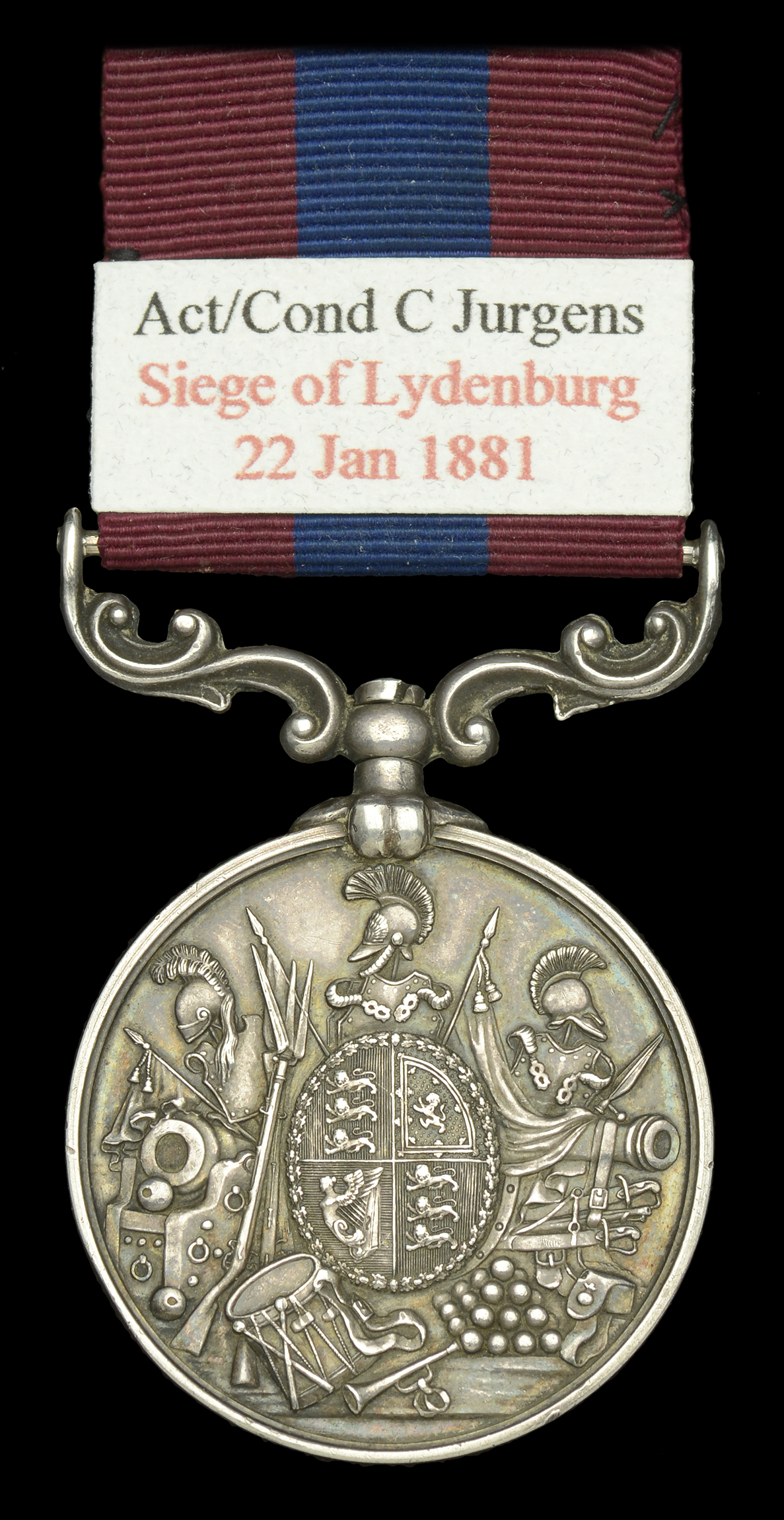A rare First Boer War ‘Siege of Lydenburg’ D.C.M. awarded to Acting Conductor C. Jurenson, Commissariat and Transport Corps, for his gallant conduct on 22 January 1881 Distinguished Conduct Medal, V.R. (Ag. Condtr. C. Jurgenson. 22nd. Jan: 1881.) minor official correction to rank, nearly extremely fine £5,000-£7,000 --- D.C.M. Recommendation submitted to the Queen 6 March 1882. The Siege of Lydenburg The garrison at Lydenburg originally consisted of the 94th Regiment, but with the exception of a small detachment, the regiment was withdrawn on 5 December 1880. The remaining troops consisted of 54 non-commissioned officers and men of the 94th, a Sergeant and 7 Sappers, R.E., 8 N.C.O.s, and men of the Commissariat and Hospital Corps, with Surgeon Falvey in medical charge, and Conductor Parsons in charge of supplies. Lieutenant Walter Long, a 24-year-old junior officer of the 94th, was placed in command, and on receipt of instructions from Pretoria immediately set to work to strengthen the defences of the town’s fort, which measured 78 yards by 20 yards, by erecting stone walls between a number of thatched-roof huts which were covered with tarpaulins. An underground magazine was constructed in which over 200,000 rounds of ammunition, left behind by the 94th, were stored. Three months’ supply of preserved meat, eight months' flour for bread making, and ample supplies of groceries and vegetables provided for a lengthy siege. On 23 December Long was visited by Dietrich Muller, who said he had been deputed by the Boer Government to demand the immediate surrender of the garrison, which was refused by Long. The Boers took up a position two miles off on the road to Middelburg on 3 January 1881, and commenced their attack on 6 January. 250 men entered the town and proclaimed the Republic, again calling on Long to surrender, which once again he refused to do. The Boer force was now estimated at between 500 and 600 men. Approaching to within 250 yards of the fort they opened fire, continuing for about 3 hours without harming the garrison. A cannon opened fire on the fort on 8 January, but the shells passed harmlessly overhead. Later, a second gun was used against the garrison which caused damage. Conductor Parsons was prominent on several occasions, leading parties to dislodge the Boers from posts too close to the Fort, crawling up to the 'Old Dutch Laager' and throwing a lighted hand grenade into the camp, causing a stampede, and, on another occasion, he tried to lay a mine but was discovered and obliged to fall back under heavy fire. On 23 January the water supply was found to be running short and the garrison was placed on short ration until a heavy rainfall on 8 February afforded relief. On 4 March the enemy successfully set fire to the thatched roofs of the fort. On the morning of 10 March, two men appeared under a flag of truce bearing a letter from Alfred Aylward, formerly editor of the Natal Witness (who had joined the Boer forces), offering favourable terms of capitulation, to which Lieutenant Long replied that he would continue to defend the Fort until he received instructions to the contrary. On 23 March the Boer Commandant sent in under a flag of truce a copy of the Natal Mercury describing Sir George Colley's defeat and death, and the terms of the armistice, but hostilities continued until 30 March 1881, when Lieutenant Baker of the 60th Regiment arrived with despatches confirming the terms of peace. The siege lasted 84 days. Casualties were 4 killed, including 2 volunteers, and 19 wounded. For their gallantry during the siege of Lydenburg, Sergeant Day, Royal Engineers; Private Whalen, 94th Foot; and Conductor Charles Jurgenson, Commissariat and Transport Corps were all awarded the D.C.M. Conductor William Parsons, considered by the contemporary press to be ‘the real hero’ of the defence was commissioned Quartermaster, specifically for his gallantry during the siege, which at the time was considered a far greater reward, both in rank and from a financial point of view, than medallic recognition.





